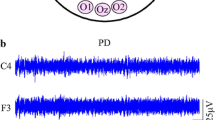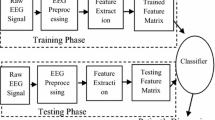Abstract
Diagnosis of Parkinson’s disease (PD) in the early stages is very critical for effective treatments. In this paper, we propose a simple and low-cost biomarker to diagnose PD, using the electroencephalography (EEG) signals. In the proposed method, EEG is used to detect the brain electrical activities in internal regions of brain, e.g., basal ganglia (BG). Based on the high correlation between PD and brain activities in the BG, the proposed method provides a highly accurate PD diagnostic measure. Moreover, we obtain a quantitative measure of the disease severity, using the spectral analysis of extracted brain sources. The proposed method is denoted by Parkinson’s disease stage detection (PDSD). The PDSD includes brain sources separation and localization steps. The accuracy of the method in detection and quantification of PD is evaluated and verified by using information of ten patients and ten healthy people. The results show that there is a significant difference in the number of brain sources within the BG region, as well as their power spectral density, between healthy cases and patients. The accuracy and the cross-validation error of PDSD to detect PD are 95% and 6.25%, respectively. Furthermore, it is shown that the total power of extracted brain sources within the BG region in the \(\alpha \) and \(\beta \) rhythms can be used effectively to determine the severity of PD.









Similar content being viewed by others
References
Aldea, R.T., Geman, O., Chiuchisan, I., Lazar, A.M.: A comparison between healthy and neurological disorders patients using nonlinear dynamic tools. In: International Conference and Exposition on Electrical and Power Engineering (EPE), pp. 299–303, IEEE, Iasi, Romania (2016)
Jackson, N., Cole, S.R., Voytek, B., Swann, N.C.: Characteristics of waveform shape in Parkinson’s disease detected with scalp electroencephalography. eNeuro 6(3), 1–11 (2019)
Mostile, G., Giuliano, L., Dibilio, V., Luca, A., Cicero, C.E., Sofia, V., Nicoletti, A., Zappia, M.: Complexity of electrocortical activity as potential biomarker in untreated parkinson’s disease. J. Neural Transm. 126(2), 167–172 (2019)
Obukhov, Y.V., Gabova, A., Zaljalova, Z., Illarioshkin, S., Karabanov, A., Korolev, M., Kuznetsova, G., Morozov, A., Nigmatullina, R., Obukhov, K.Y., et al.: Electroencephalograms features of the early stage parkinson’s disease. Pattern Recognit. Image Anal. 24(4), 593–604 (2014)
Chiang, J., Wang, Z.J., McKeown, M.J.: A generalized multivariate autoregressive (GmAR)-based approach for EEG source connectivity analysis. IEEE Trans. Signal Process. 60(1), 453–465 (2012)
Ornelas-Vences, C., Sánchez-Fernández, L.P., Sánchez-Pérez, L.A., Martínez-Hernández, J.M.: Computer model for leg agility quantification and assessment for parkinson’s disease patients. Med. Biol. Eng. Comput. 57, 1–14 (2018)
Oh, S.L., Hagiwara, Y., Raghavendra, U., Yuvaraj, R., Arunkumar, N., Murugappan, M., Acharya, U.R.: A deep learning approach for parkinson’s disease diagnosis from EEG signals. Neural Comput. Appl. (2018). https://doi.org/10.1007/s00521-018-3689-5
Chen, X., Chen, X., Ward, R.K., Wang, Z.J.: A joint multimodal group analysis framework for modeling corticomuscular activity. IEEE Trans. Multimed. 15(5), 1049–1059 (2013)
Turner, R.S., Desmurget, M.: Basal ganglia contributions to motor control: a vigorous tutor. Curr. Opin. Neurobiol. 20(6), 704–716 (2010)
Stocco, A.: A biologically plausible action selection system for cognitive architectures: implications of basal ganglia anatomy for learning and decision-making models. Cogn. Sci. 42(2), 457–490 (2018)
Gatev, P., Wichmann, T.: Interactions between cortical rhythms and spiking activity of single basal ganglia neurons in the normal and parkinsonian state. Cereb. Cortex 19(6), 1330–1344 (2008)
Wichmann, T., DeLong, M.R.: Deep brain stimulation for movement disorders of basal ganglia origin: restoring function or functionality? Neurotherapeutics 13(2), 264–283 (2016)
Griffanti, L., Rolinski, M., Szewczyk-Krolikowski, K., Menke, R.A., Filippini, N., Zamboni, G., Jenkinson, M., Hu, M.T., Mackay, C.E.: Challenges in the reproducibility of clinical studies with resting state fMRI: an example in early parkinson’s disease. Neuroimage 124, 704–713 (2016)
Jatoi, M.A., Kamel, N.: Brain Source Localization Using EEG Signal Analysis. CRC Press, Boca Raton (2017)
Yan, H., Wang, J.: Quantification of motor network dynamics in parkinson’s disease by means of landscape and flux theory. PloS One 12(3), e0174364 (2017)
Motamedi-Fakhr, S., Moshrefi-Torbati, M., Hill, M., Hill, C.M., White, P.R.: Signal processing techniques applied to human sleep eeg signals-a review. Biomed. Signal Process. Control 10, 21–33 (2014)
Buciu, I., Kotropoulos, C., Pitas, I.: Comparison of ICA approaches for facial expression recognition. Signal Image Video Process. 3(4), 345 (2009)
Tharwat, A.: Independent component analysis: an introduction. Appl. Comput. Inform. (2018). https://doi.org/10.1016/j.aci.2018.08.006
Jatoi, M.A., Kamel, N.: Brain source localization using reduced eeg sensors. Signal Image Video Process. 12(8), 1447–1454 (2018)
Hallez, H., Vanrumste, B., Grech, R., Muscat, J., De Clercq, W., Vergult, A., D’Asseler, Y., Camilleri, K.P., Fabri, S.G., Van Huffel, S., et al.: Review on solving the forward problem in eeg source analysis. J. Neuroeng. Rehabilit. 4(1), 1–29 (2007)
Barton, M.J., Robinson, P.A., Kumar, S., Galka, A., Durrant-Whyte, H.F., Guivant, J., Ozaki, T.: Evaluating the performance of kalman-filter-based eeg source localization. IEEE Trans. Biomed. Eng. 56(1), 122–136 (2009)
Rodríguez-Rivera, A., Van Veen, B.D., Wakai, R.T.: Statistical performance analysis of signal variance-based dipole models for meg/eeg source localization and detection. IEEE Trans. Biomed. Eng. 50(2), 137–149 (2003)
Gorodnitsky, I.F., Rao, B.D.: Sparse signal reconstruction from limited data using focuss: a re-weighted minimum norm algorithm. IEEE Trans. Signal Process. 45(3), 600–616 (1997)
de Peralta Menendez, R.G., Andino, S.G., Lantz, G., Michel, C.M., Landis, T.: Noninvasive localization of electromagnetic epileptic activity. i. method descriptions and simulations. Brain Topogr. 14(2), 131–137 (2001)
Baillet, S., Garnero, L.: A bayesian approach to introducing anatomo-functional priors in the eeg/meg inverse problem. IEEE Trans. Biomed. Eng. 44(5), 374–385 (1997)
Riera, J., Valdes, P., Fuentes, M., Oharriz, Y.: Explicit Backus and Gilbert EEG Inverse Solution for Spherical Symmetry. Department of Neurophysics, Cuban Neuroscience Center, Havana (2002)
Grech, R., Cassar, T., Muscat, J., Camilleri, K.P., Fabri, S.G., Zervakis, M., Xanthopoulos, P., Sakkalis, V., Vanrumste, B.: Review on solving the inverse problem in EEG source analysis. J. Neuroeng. Rehabilit. 5(1), 25 (2008)
Charvátová, H., Procházka, A., Vaseghi, S., Vyšata, O., Vališ, M.: Gps-based analysis of physical activities using positioning and heart rate cycling data. Signal Image Video Process. 11(2), 251–258 (2017)
Delorme, A., Makeig, S.: Eeglab: an open source toolbox for analysis of single-trial EEG dynamics including independent component analysis. J. Neurosci. Methods 134(1), 9–21 (2004)
Mantini, D., Franciotti, R., Romani, G.L., Pizzella, V.: Improving MEG source localizations: an automated method for complete artifact removal based on independent component analysis. NeuroImage 40(1), 160–173 (2008)
Gutiérrez, D., Nehorai, A., Muravchik, C.H.: Estimating brain conductivities and dipole source signals with EEG arrays. IEEE Trans. Biomed. Eng. 51(12), 2113–2122 (2004)
Nuwer, M.R., Comi, G., Emerson, R., Fuglsang-Frederiksen, A., Guérit, J.-M., Hinrichs, H., Ikeda, A., Luccas, F.J.C., Rappelsburger, P.: IFCN standards for digital recording of clinical EEG. Electroencephalogr. Clin. Neurophysiol. 106(3), 259–261 (1998)
Hoehn, M.M., Yahr, M.D.: Parkinsonism: onset, progression and mortality. Neurology (2001)
Han, C.-X., Wang, J., Yi, G.-S., Che, Y.-Q.: Investigation of EEG abnormalities in the early stage of Parkinson’s disease. Cogn. Neurodyn. 7(4), 351–359 (2013)
Tang, T., Chen, S., Zhao, M., Huang, W., Luo, J.: Very large-scale data classification based on k-means clustering and multi-kernel SVM. Soft Comput. 23(11), 3793–3801 (2019)
Author information
Authors and Affiliations
Corresponding author
Additional information
Publisher's Note
Springer Nature remains neutral with regard to jurisdictional claims in published maps and institutional affiliations.
Rights and permissions
About this article
Cite this article
Naghsh, E., Sabahi, M.F. & Beheshti, S. Spatial analysis of EEG signals for Parkinson’s disease stage detection. SIViP 14, 397–405 (2020). https://doi.org/10.1007/s11760-019-01564-8
Received:
Revised:
Accepted:
Published:
Issue Date:
DOI: https://doi.org/10.1007/s11760-019-01564-8




